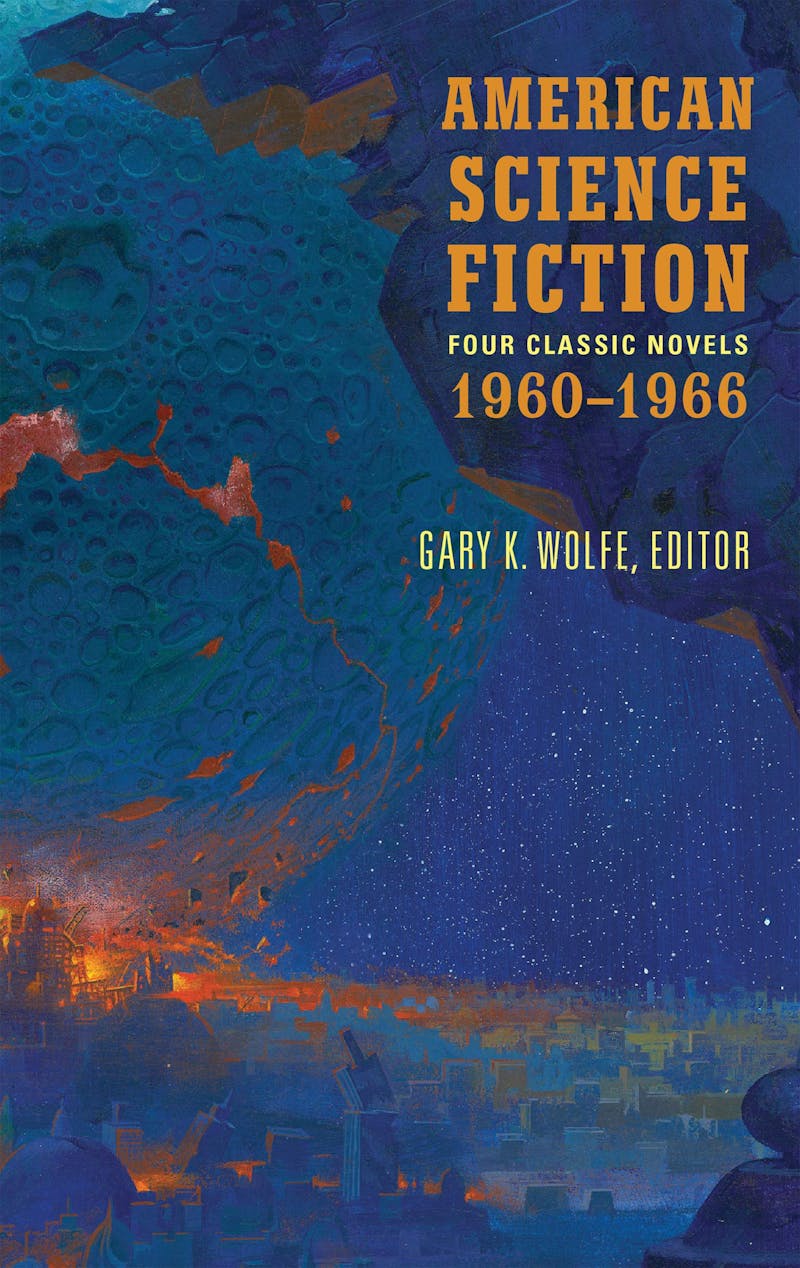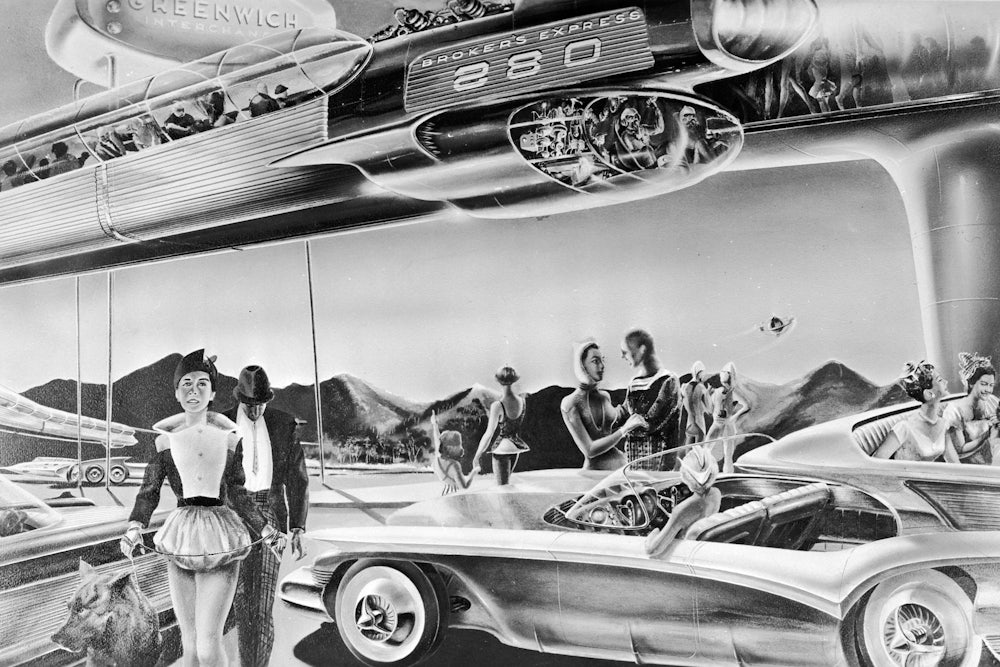From the mid-1920s, when Hugo Gernsback coined the term “science fiction,” several fallacies became associated with the increasingly vigorous commercial genre and never entirely went away. The first was the “Taught Me Science Fallacy,” which goes something like this: Isaac Asimov writes about science and particle physics, so if I read the Foundation trilogy, I might learn what a neutrino is. (Kingsley Amis argued in his influential New Maps of Hell in 1960 that, at the very least, the “aim” of sci-fi was to do “justice to the laws of nature.”) But while it is theoretically possible for someone to learn science from a science fiction novel, it would probably be foolish to read the entire Foundation trilogy—concerning a secret tribe of “psycho-historians” who design millions of years of future history before it happens—to learn something. In fact, if you read the Foundation trilogy and put it down thinking, “Ah, a neutrino!” then you very likely missed the point of that ridiculous and absorbing set of novels.

Second, and more annoying, is the “Predictive Fallacy.” This suggests that science fiction might accurately describe what the world will be like 100 years after we’re dead. This argument usually runs along the line of: “Arthur C. Clarke wrote 2001: A Space Odyssey, and guess what? A few years later we went to the moon!” Or it cites the various occasions when some story described television sets, microwaves, escalators, and two-way video phone calls and then, voilà, they happened. But of course, sci-fi novels—both good and bad—are littered with gadgets that happened and didn’t happen; what they never foresaw was how (and usually how poorly) those inventions would be implemented. Show me one novel that predicted something like Fox and Friends, or The View. You can’t do it. (Oh, well, maybe C.M. Kornbluth’s “The Marching Morons.” But let’s move on.)
Finally, there’s the “Cautionary Fallacy,” which suggests that science fiction provides urgent warnings about our collective need to prepare for world-hammering comets, nuclear war, climate catastrophe, totalitarian mind-control, and so forth. In support of this fallacy, people say things like: “George Orwell warned us about the Thought Police, and now we’ve got Nancy Pelosi!” (“I don’t want to predict the future—I want to prevent it” was a line often attributed to Ray Bradbury.) The idea that human beings require explicit fictional warnings about their increasingly world-destroying stupidities seems like an exercise in futility, doesn’t it? And by the way, science fiction has long warned readers about things like climate catastrophe—but nothing was done about it. And the imminence of totalitarianism. (Check.) And even the suicidal ridiculousness of mutually assured nuclear destruction—and guess what? We have more bombs than ever.
The science fiction novels of the 1960s—as this two-volume collection of eight very different sci-fi novels testifies—remain enjoyable because they got everything wrong. They didn’t accurately predict the future of space travel, or what a postnuclear landscape would look like, or how to end intergalactic fascism. They didn’t warn us against the roads we shouldn’t travel, since they probably suspected we were going to take those roads anyway. And they definitely didn’t teach us what a neutrino is. But what ’60s science fiction did do was establish one of the wildest, widest, most stylistically and conceptually various commercial spaces for writing (and reading) fiction in the history of fictional genres. Each book is unpredictable in so many ways as to almost constitute its own genre.
Take, for example, Samuel R. Delany’s influential space opera, Nova (presented here in a newly corrected, author-approved text), which takes the concept of the “cybernetic” fusion of human and machine and runs with it. Nova envisions a universe boiling over with star-hopping spaceships, spine-socketed crew members, weirdly mutated sexual and familial relationships, synesthetic video-art instruments, and at least one character raised on another planet who speaks in a verb-delaying syntax several years before Yoda was a gleam in George Lucas’s eye. (“Not too good going to be is. Out of practice am.”) Delany’s prose was stylistically bright, fizzing with ambitious energy (he began publishing novels in his late teens and won several major awards early) and relentlessly inventive, with flashy new visions of the future in one paragraph after another.
Then there’s Jack Vance, who also wrote about incomprehensibly far-off futures that weren’t driven by the splashy intergalactic military conflicts of his Golden Age predecessors, such as E.E. Doc Smith or Robert A. Heinlein. Instead, Vance’s futures are marked by rich, panoramic socioeconomic systems. One of his best is Emphyrio, which charts the coming of age of a young economic adventurer named Ghyl Tarvoke in a galaxy ruled by “lords” and “ladies” who flit from star to star in their luxury space-liners while planet-bound artisans must produce beautiful objects for them to buy and enjoy. People rarely blast each other with laser pistols in a Vance novel; they are more likely to buy one another out or break their distribution chains. (In that way, he is similar to his friend and contemporary, Frank Herbert.) Yet, like Delany, Vance can suggest vast, unimaginable strangenesses in a few sentences, such as when he describes a far-future County Pavilion where highborn elites come down from their “eyries” to mix with the lower orders:
Back and forth along the floor stepped the dancers, graceful-grotesque, grotesque-graceful. There were simulations of a hundred sorts: clowns, demons, heroes; folk from far stars and ancient times; creatures of fantasy, nightmare, faery. The pavilion was rich. There was glitter of metal, the soft sheen of silk; gauze in every color; black leather, black wood, black velvet.
Just as it’s impossible to read early William Gibson without seeing the influence of Delany, it’s equally impossible to read Gene Wolfe’s far-future science fantasies without seeing the influence of Vance.
And then there’s Poul Anderson who, even in what might be considered his more “traditional” version of space opera, wrote continually surprising books. The High Crusade was originally published in Astounding by the influential and exasperating John W. Campbell, who also published the best early work of Asimov and Heinlein, as well as L. Ron Hubbard’s early Dianetics essays. Like many Campbell-inspired writers, Anderson was a “libertarian,” and he once wrote a science fiction novel in which the world is oppressed by an evil socialist empire. In The High Crusade, a band of medieval British holy crusaders gets diverted from France by an invasion of alien tyrants, but the joke, of course, is on the alien tyrants. The knights quickly demolish the invaders, ride their horses onto the captured spaceship, and fiddle a few knobs until they figure out how to traverse space and fire futuristic weaponry. Then—the stars! Anderson’s work is often held up as an example of “hard S.F.,” which relies on scientific accuracy. (Yeah, knights in steel armor prancing around spaceships on horses. Science.)
It’s impossible to encapsulate the wide variety of styles and stories contained by these Library of America volumes, but many of the best never even leave Earth. There’s the classic Flowers for Algernon, told through the diary of a mentally limited young man as he is subjected to an intelligence-enhancing drug. Or Way Station, a perfect example of Clifford D. Simak’s often poetic and moving “rural S.F.,” in which a Civil War soldier, enlisted by a galactic federation, maintains a secret travel stop for star-hopping aliens in the Wisconsin woods. (Simak was another of Campbell’s regulars who advocated “plausible” science fiction.) Or Roger Zelazny’s Hugo Award–winning This Immortal (here published under Zelazny’s preferred title, And Call Me Conrad) describing a post–nuclear holocaust Earth populated by both prewar cultures and new, mutant ones. (In the event of an actual nuclear holocaust, we should be so lucky.)
Finally, two more novels that are as unlike one another as they are unlike any of the other novels in these volumes. In Joanna Russ’s Picnic on Paradise, far-future tourists are guided across an alien war zone by a young, lithe barbarian woman, time traveled in from the past; Past Master, by R.A. Lafferty, concerns a future war between Mankind and armies of “mechanical killers,” to which Saint Thomas More is summoned from the past, the logic being: What Mankind requires is someone who is capable of doing the “right” thing, and More did the right thing once—so might as well give him another try. And that’s easily the most plausible bit in the entire book, which is otherwise packed with Lafferty’s typically irascible comic genius. If the manically inventive Flann O’Brien had been transported to Oklahoma as a young boy and taken a correspondence degree in engineering, he might well have turned into R.A. Lafferty.
It’s one of the unwinnable games of both assembling and reviewing such a monolithic-looking collection to ask—what shouldn’t have been left out? The only thing I miss from this generally optimistic set of novels—in which humanity successfully expands throughout the universe, overcomes its worst inventions, and always survives to fight another day—is one of those really black, bleak, and hilarious novels by either Thomas M. Disch (in The Genocides, his proud God-worshipping humans stand tall against alien invaders and are abruptly slaughtered—after which things get much worse) or John Sladek (in Mechasm, the military-industrial complex invents a machine with one sole purpose—to devour everything it finds and use its materials to endlessly manufacture iterations of itself). Now those are two predictions about our collective future that possess, for me, credibility.
